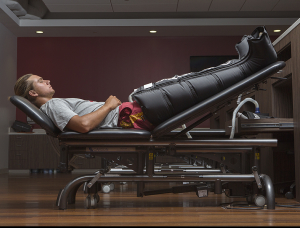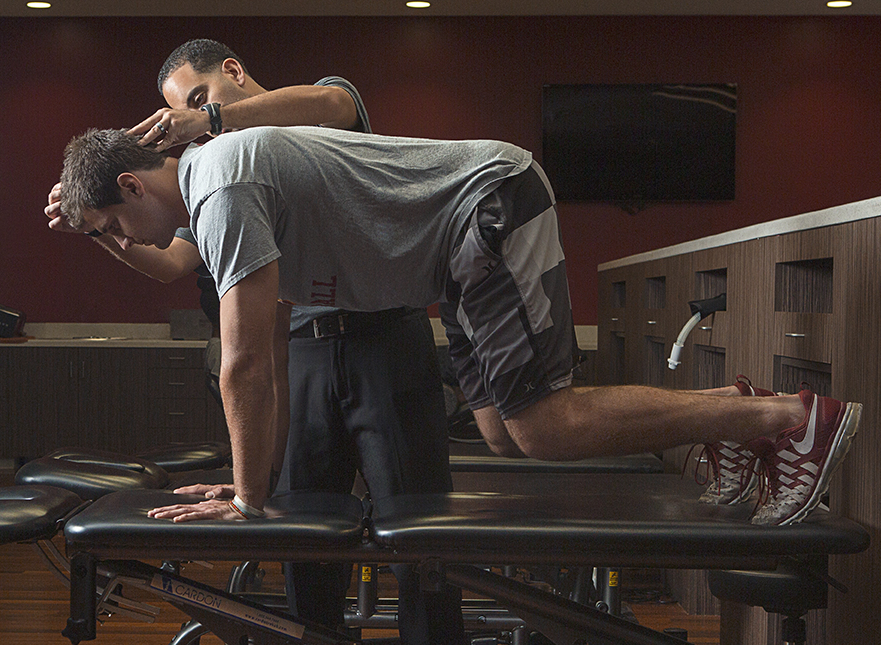The first time that Russ Romano, associate athletic director for athletic medicine, asked Stephen Reischl to come look at one of his athletes was in 1999.
One of the Trojan football players had been sidelined with a bad ankle, and Reischl, DPT, adjunct associate professor for clinical physical therapy, specializes in disorders of the foot and ankle. Reischl found that the player had significant dysfunction in his ankle. Teaming with Romano, they developed a new training regimen that kept the player out of the operating room and got him back on the field for his entire senior year. Romano and Reischl cheered their combined effort when that player went on to play in the NFL.
Over time, Reischl looked at other athletes, and eventually Romano asked other faculty members from biokinesiology and physical therapy to consult on difficult problems with other athletes. What started as a one-time consultation has grown into an ongoing partnership that is in its second decade.
Today, the USC Athletic Medicine Department continues to combine the talents of world-class athletic trainers and advice from physical therapists at the nation’s top-rated physical therapy school, the USC Division of Biokinesiology and Physical Therapy, to keep athletes performing at their peak.
“USC is a special place, and one of the ways it is special is there are smart people in many departments who can help us provide the absolute best health care for the student athletes,” Romano said.
Reischl serves as a permanent liaison between the departments, and Romano has since hired four doctor of physical therapy graduates (John Meyer, Andrew (Drew) Morcos, Stephanie Hong and Lisa Noceti-DeWit) — three of whom are also division faculty members — from the division’s doctor of physical therapy program to help keep USC’s athletes healthy. Meyer was recently promoted to associate athletic director for sports science and performance.
Treatment of athletic injuries has evolved in recent years, as has the practice of physical therapy. Morcos, rehabilitation coordinator for the John McKay Center, said athletic injuries in the past were often treated with ice and rest. Treating injuries in that fashion not only takes longer than necessary, but it often fails to correct whatever problem led to the injury in the first place.
These days, the physical therapy team at USC is squarely focused on preventing injury so that fewer athletes get sidelined.

Tennis player Connor Farren receives treatment to circulate blood flow in his legs. (Photo/Nate Jensen)
At tennis practice, coaches and Morcos study the athletes’ movements. While coaches watch players serve to see how much spin they can put on a ball or how fast they can get the ball over the net, Morcos is reading the way they move and determining whether they are doing anything that could cause injury.
Morcos points out that many injuries are the result of moving in a way that, if repeated for a long time, can cause damage.
The first thing that Trojan athletes do before each new season is report for a lengthy preseason screening. Trainers want to make sure nobody is returning with lingering muscle strain or with pain in one of their joints. Testing evaluates each athlete for problems in mobility, strength and flexibility. If an athlete is weak in one set of muscles or lacks flexibility in another, the trainer might tailor a program to help deal with the problem before it leads to an injury.
Incorporating physical therapists into an athletic training staff has become more common, Reischl said, but not every university can do so because they don’t have a physical therapy school to tap for insights and information on the latest research.

Basketball player Temi Fagbenle runs on the underwater treadmill to rehab her tendonitis. (Photo/Nate Jensen)
One research-based project that has held promise for prevention of injury has been in women’s basketball.
Historically, female college basketball players have had higher rates of anterior cruciate ligament (ACL) tears than other athletes. For three years, the USC women’s basketball squad has undergone motion analysis in the division’s human performance laboratory, which does research on the prevention and rehabilitation of knee injuries in athletes. The research has informed the way that the players train and, during the research period, the team has not had knee problems.
Having the ability to work with USC athletes has also helped fortify the research being done by division faculty.
Kornelia Kulig, PhD, professor of biokinesiology and physical therapy, has advanced the understanding of patellar tendinitis, or jumper’s knee, through research with USC volleyball players, for example.
The partnership with USC Athletics is mutually beneficial, with the experience benefiting students such as third-year doctor of physical therapy candidate Brian Lee, who is the first division student to do a full-time clinical affiliation at USC Athletic Medicine.
Lee said that sports are his passion. In fact, his love of sports first introduced him to the idea of pursuing a career in physical therapy. As of this fall, he has been treating top Trojan athletes during the 16-week clinical affiliation.
“No classroom or textbook could replicate the real-life, hands-on experience I have been getting during this clerkship,” said Lee, who plans to do a sports residency after completing his degree. “With every patient interaction an opportunity for learning and self-assessment, there is no better place to start to become an expert in sports rehabilitation than at USC Athletic Medicine.”
— Hope Hamashige


